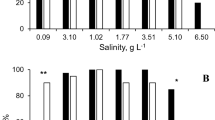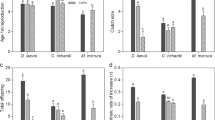Abstract
Survival of natural Daphnia populations without previous acclimatization in filtered water under laboratory conditions (starvation) was used as a parameter describing the actual competitive ability of populations in periods of food limitation. Two populations (1 and 2) of Daphnia pulicaria Forbes coming from two enclosures with a low (< 1 mgC l−1) and a high (about 3 mgC l−1) seston level were examined in their resistance to starvation. Juveniles of both populations survived better than adult females in the conditions without seston as well as in the control experiment, despite their much lower biomass. Animals from population 1 had lower mortality than those from population 2 in all variants of the experiment. The results confirm the hypothesis that the ability of daphnids to starve depends also on adaptation to previous feeding conditions.
Similar content being viewed by others
References
Černý M. & J. Bytel, 1991. Density and size distribution of Daphnia populations at different fish predation levels. In: Kořínek, V. & D. G. Frey (eds), Biology of Cladocera. Developments in Hydrobiology 71. Kluwer Academic Publishers, Dordrecht: 199–208. Reprinted from Hydrobiologia 225.
Hráčková-Esslová, M., 1963. The development of three species of Daphnia in the surface water of the Slapy reservoir. Int. Revue ges. Hydrobiol. 48: 325–333.
Hráčková, M. & J. Hráček, 1978. The growth rate of Daphnia pulex and Daphnia pulicaria (Crustacea: Cladocera) at different food levels. Věst. čs. Spoleç. zool. 42: 115–127.
Kořínek, V., J. Fott, J. Fuksa, J. Lellák & M. Pražáková, 1987. Carp ponds in Central Europe. In R.G. Michael (ed.), Managed Aquatic Ecosystems. Elsevier Science Publishers B.V., Amsterdam: 29–62.
Lemcke, H. W. & W. Lampert, 1977. Veranderungen im gewicht und der chemischen zusammensetzung von Daphnia pulex im hunger. Arch. Hydrobiol. Suppl. 48: 108–137.
Mackereth, F. J. H., J. Heron & J. F. Talling, 1978. Water analysis: Some revised methods for limnologists. FBA Scientific publication No. 36, 120 pp.
Novotná, Z., 1987. Vliv koncentrace potravy na parametry biomasy u několika druhd rodů Daphnia. M.Sc. Thesis, Charles University, Prague, 69 pp. [Effect of concentration of food on biomass parameters within several species of the genus Daphnia.]
Pechar, L., 1987. Use of an acetone: methanol mixture for the extraction and spectrophotometric determination of chlorophyll-a in phytoplankton. Arch. Hydrobiol. Suppl. 78: 99–117.
Porter, K. G., J. Gerritsen & J. D. Orcutt, Jr., 1982. The effect of food concentration on swimming patterns, feeding behavior, ingestion, assimilation, and respiration by Daphnia. Limnol. Oceanogr. 27: 935–949.
Salonen, K. & T. Hammar, 1986. On the importance of dissolved organic matter in the nutrition of zooplankton in some lake waters. Oecologia (Berlin) 68: 246–253.
Tessier, A. J., L. L. Henry, C. E. Goulden & M. W. Durand, 1983. Starvation in Daphnia: Energy reserves and reproductive allocation. Limnol. Oceanogr. 28: 667–676.
Threlkeld, S. T., 1976. Starvation and the size structure of zooplankton communities. Freshwat. Biol. 6: 486–496.
Author information
Authors and Affiliations
Rights and permissions
About this article
Cite this article
Stuchlíková, Z. Effect of previous feeding conditions on survival in Daphnia pulicaria (Crustacea: Cladocera). Hydrobiologia 225, 177–183 (1991). https://doi.org/10.1007/BF00028395
Issue Date:
DOI: https://doi.org/10.1007/BF00028395




